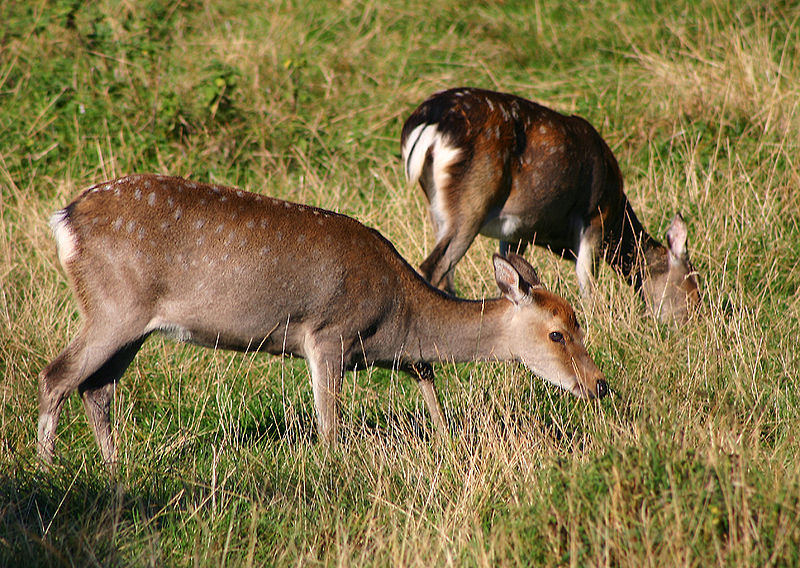Cervus nippon
Sika Deer
Synonym(s):
Class: Mammalia
Order: Artiodactyla
Family: Cervidae

Photographer: Malene Thyssen
Source: http://commons.wikimedia.org/wiki/User:Malene
Description
Sika deer (Cervus nippon) are similar to invasive Axis deer (Axis axis) in appearance with white spots present on the back through adulthood. However, sika deer have a black stripe down the back where the spine would be and a white patch on the posterior end surrounded by black hair. The overall body color of sika deer is tan to brown that becomes gray in the winter. Adult male sika deer have antlers with horns pointing forward (anteriorly) instead of inwards or towards the ears.
Ecological Threat: Sika deer are aggressive foragers that are known to cause significant damage to vegetation in natural and commercial areas. Farmers often suffer losses of crops and surrounding woodland areas. Sika deer are known to feed most frequently on trees, shrubs, grasses, sedges, holly, conifers, fungi, acorns, bark, heather, and ivy. The ecological niche occupied by sika deer is similar to whitetail deer and red deer allowing for chances to hybridize. Several instances of hybridization between sika deer and red deer have been observed. Hybridization is detrimental to native deer species that suffer losses in the gene pool leading to reduced species diversity.
Biology: Unlike native whitetail deer, sika deer are active 24 hours a day with the exception of disturbed areas that are highly populated by humans. In these habitats sika deer are only active during dark hours of the night. Sika deer are known to live in small to large herds or individually. Herds form and become larger in the fall and winter months creating dense populations. Breeding season is identified by characterisitc rut behavior exhibited by male sika deer from late August to October. Males will compete with other males for females by selecting a mating territory and defending it by parallel walking, screaming, and eventually fighting. Male-male competitions are very aggressive and can often result in the death of the losing stag. Mating occurs post-competition with litters of one calf born in May or June.
History: Sika deer are native to Japan and Southern Sibera, but have spread to over 77 countries due to intentional introduction for game food or accidentally because of habitat loss. In the state of Texas, sika deer became established rapidly due to favorable environmental conditions with free range populations reaching over 11,000 by 1988.
U.S. Habitat: Sika deer prefer habitats with lush vegetation for feeding that are surrounded by forests for shelter and places to hide. With a strong preference for warmer weather the sika deer easily became established in the piney forests of Texas. Sika deer can also be found in gardens and farmland foraging for food.
Distribution
Native Origin: Japan
U.S. Present: MD, TX
Management
Management of sika deer in the United States is facilitated by legalized hunting with required permits released by local parks and wildlife authorities. Population control is necessary to prevent further spread and establishment of the invasive sika deer in the United States, but it is also important to follow all required laws implemented by state and federal agencies for hunting.
More information - sika deer hunting in Maryland
More information - sika deer hunting in Texas
References
Abernathy, K. 1994. The establishment of a hybrid zone between red and sika deer (genus Cervus). Molecular Ecology 3(6): 551-562.
Internet Sources
 Texas Invasive Species Institute
Texas Invasive Species Institute